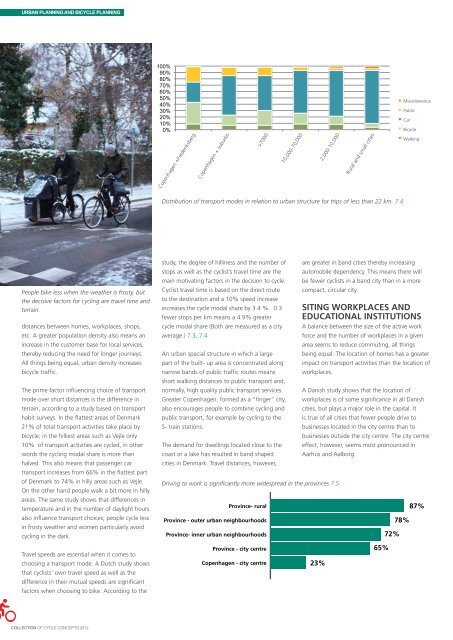Collection of Cycle Concepts 2012.pdf - Fietsberaad
Collection of Cycle Concepts 2012.pdf - Fietsberaad
Collection of Cycle Concepts 2012.pdf - Fietsberaad
Create successful ePaper yourself
Turn your PDF publications into a flip-book with our unique Google optimized e-Paper software.
URBAN PLANNING AND BICYCLE PLANNING<br />
100%<br />
90%<br />
80%<br />
70%<br />
60%<br />
50%<br />
40%<br />
30%<br />
20%<br />
10%<br />
0%<br />
Kbh+Frederiksberg<br />
Copenhagen +Frederiksberg<br />
Kbh. forstader<br />
Copenhagen + suburbs<br />
>7000<br />
>70000<br />
10-70000<br />
10,000-70,000<br />
2-10000<br />
2,000-10,000<br />
Land og små byer<br />
Rural and small cities<br />
Diverse Miscellaneous<br />
Kollektiv Public<br />
Bil Car<br />
Cykel Bicycle<br />
Gang Walking<br />
Distribution <strong>of</strong> transport modes in relation to urban structure for trips <strong>of</strong> less than 22 km. 7.4<br />
People bike less when the weather is frosty, but<br />
the decisive factors for cycling are travel time and<br />
terrain.<br />
distances between homes, workplaces, shops,<br />
etc. A greater population density also means an<br />
increase in the customer base for local services,<br />
thereby reducing the need for longer journeys.<br />
All things being equal, urban density increases<br />
bicycle traffic.<br />
The prime factor influencing choice <strong>of</strong> transport<br />
mode over short distances is the difference in<br />
terrain, according to a study based on transport<br />
habit surveys. In the flattest areas <strong>of</strong> Denmark<br />
21% <strong>of</strong> total transport activities take place by<br />
bicycle; in the hilliest areas such as Vejle only<br />
10% <strong>of</strong> transport activities are cycled, in other<br />
words the cycling modal share is more than<br />
halved. This also means that passenger car<br />
transport increases from 66% in the flattest part<br />
<strong>of</strong> Denmark to 74% in hilly areas such as Vejle.<br />
On the other hand people walk a bit more in hilly<br />
areas. The same study shows that differences in<br />
temperature and in the number <strong>of</strong> daylight hours<br />
also influence transport choices; people cycle less<br />
in frosty weather and women particularly avoid<br />
cycling in the dark.<br />
Travel speeds are essential when it comes to<br />
choosing a transport mode. A Dutch study shows<br />
that cyclists’ own travel speed as well as the<br />
difference in their mutual speeds are significant<br />
factors when choosing to bike. According to the<br />
study, the degree <strong>of</strong> hilliness and the number <strong>of</strong><br />
stops as well as the cyclist’s travel time are the<br />
main motivating factors in the decision to cycle.<br />
Cyclist travel time is based on the direct route<br />
to the destination and a 10% speed increase<br />
increases the cycle modal share by 3.4 %. 0.3<br />
fewer stops per km means a 4.9% greater<br />
cycle modal share (Both are measured as a city<br />
average.) 7.3, 7.4<br />
An urban spacial structure in which a large<br />
part <strong>of</strong> the built- up area is concentrated along<br />
narrow bands <strong>of</strong> public traffic routes means<br />
short walking distances to public transport and,<br />
normally, high quality public transport services.<br />
Greater Copenhagen, formed as a “finger” city,<br />
also encourages people to combine cycling and<br />
public transport, for example by cycling to the<br />
S- train stations.<br />
The demand for dwellings located close to the<br />
coast or a lake has resulted in band shaped<br />
cities in Denmark. Travel distances, however,<br />
Driving to work is significantly more widespread in the provinces 7.5<br />
Province- rural<br />
Province - outer urban neighbourhoods<br />
Province- inner urban neighbourhoods<br />
Province - city centre<br />
Copenhagen - city centre<br />
are greater in band cities thereby increasing<br />
automobile dependency. This means there will<br />
be fewer cyclists in a band city than in a more<br />
compact, circular city.<br />
SITING WORKPLACES AND<br />
EDUCATIONAL INSTITUTIONS<br />
A balance between the size <strong>of</strong> the active work<br />
force and the number <strong>of</strong> workplaces in a given<br />
area seems to reduce commuting, all things<br />
being equal. The location <strong>of</strong> homes has a greater<br />
impact on transport activities than the location <strong>of</strong><br />
workplaces.<br />
A Danish study shows that the location <strong>of</strong><br />
workplaces is <strong>of</strong> some significance in all Danish<br />
cities, but plays a major role in the capital. It<br />
is true <strong>of</strong> all cities that fewer people drive to<br />
businesses located in the city centre than to<br />
businesses outside the city centre. The city centre<br />
effect, however, seems most pronounced in<br />
Aarhus and Aalborg.<br />
23%<br />
65%<br />
72%<br />
78%<br />
87%



